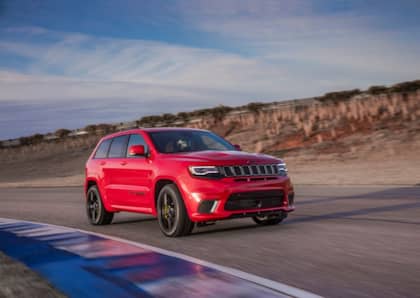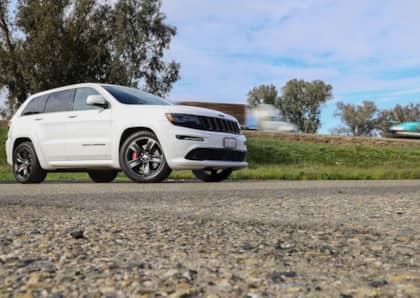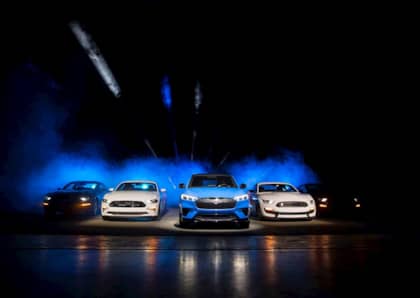2020 Jeep Grand Cherokee Trackhawk vs. 2021 Mustang Mach E: Changing Of The Domestic Super SUV Guard?
The apex predator of the performance SUV world is undoubtedly the Jeep Grand Cherokee Trackhawk. While other, pricier haulers from Porsche (the Cayenne Turbo) and BMW (the X5 M) might deliver smoother handling or a larger helping of luxury features, nothing else features the shock and awe of the Trackhawk's Hellcat-sourced, 707hp supercharged V8 engine, a power plant that causes even the mightiest twin-turbo Euro rival to cower in its presence.

Is it possible, however, that the greatest threat to the Jeep's thunderous SUV dominance comes not from any of its gas-powered rivals but instead a fossil fuel-free upstart's sound of silence? And that this next-generation performance sport-utility hails not from the other side of the Atlantic but rather across town in Detroit?

The Mustang Mach-E is a potential game-changer, not just for the small niche of electric vehicle fans but also those who crave a mix of practicality and performance in a single do-everything package. Although it might seem odd to compare an electric SUV to the most debauched muscle truck ever built, this pair of people movers have more than a little in common when it comes to straight-line thrills—even if they do take dramatically different paths to achieve nearly the same end result.
Despite the Mach-E being several months away from launch we know quite a bit already about what the electric Mustang SUV is bringing to the table. After spending a week behind the wheel of the 2020 Jeep Grand Cherokee Trackhawk, it only felt right to compare the experience to what Ford is promising in the upcoming Mach-E and see what the changing of the super SUV guard might look like.
Great Big Torque
On paper the battle between the Jeep Grand Cherokee Trackhawk and the Ford Mustang Mach-E appears to be a mismatch. The former boasts 707 horsepower and 645 lb-ft of torque from a supercharged 6.2-liter V8 engine, sent to all four-wheels via a full-time four-wheel drive system, and managed by an eight-speed automatic transmission.

In contrast, the highest performance version of the Mustang Mach-E, the GT, is motivated by a pair of electric motors that together produce 459 horsepower and 612 lb-ft of torque. As with many electric vehicles, this all-wheel drive setup doesn't require the use of a traditional transmission.

With nearly 250 horses less in the Mach-E compared to the Trackhawk, it's reasonable to expect that the Jeep would flatten the Ford in a straight line, even given the much smaller gap in torque between the two vehicles. In reality, the difference between the two is a blink-and-you'll-miss-it question of milliseconds.
Jeep claims that the Grand Cherokee Trackhawk, with launch control enabled, will hit 60-mph from a standing start in 3.5 seconds. Ford, on its side, is making an identical claim for the Mach-E. It's worth noting that in real-world testing the Trackhawk has been able to cut a few tenths of a second off of that published figure, and it's reasonable to expect the Mustang Mach-E GT to over-achieve to the same degree.

What accounts for the Ford Mustang Mach-E's startling acceleration despite its horsepower handicap? There are two factors to consider when comparing these mega-SUVs, with the first being weight. The heaviest version of the electric Mustang sport-utility checks in at 4,890 lbs, which makes it only 300 lbs heavier than a Dodge Charger Hellcat. It also positions it a whopping 550 lbs below the Trackhawk (which at 5,448 lbs is 999 lbs chunkier than a Challenger Hellcat), and that goes a long way towards leveling the playing field in terms of speed.

Next up is the unique torque delivery of electric motor designs. Capable of blasting out 100 percent of its 615 lb-ft as soon as the go-pedal is pushed, there's no powerband to stay in or shifting to do during its sprint, which means a properly-programmed traction control system can make the most of all that forward thrust.
Race Track Equalizer
How the Ford Mustang Mach-E will handle twisting roads and challenging road courses is a little less certain.
Having driven the Jeep Grand Cherokee Trackhawk on both a race track and numerous two-lane tracts of asphalt, it's clear that the SUV can more than hold its own. Helping to mitigate the effects of its ponderous weight and elevated center of gravity are massive 295/45 R20 tires and of course four-wheel drive, each of which adds the kind of grip required to flaunt physics when changing direction.

Combine the above with a set of well-tuned electronic driver's aides, and you have a recipe for a truck that is certainly competent lap after lap, but which isn't exactly what you'd call fun. That being said, the suspension of disbelief as the behemoth Jeep manages to stay on course is a trip all its own.
Similarly, it's reasonable to expect that the Mach-E will offer a comparable level of grip from oversized rubber, and with a software safety net to match in terms of apportioning power to the right spot and at the right moment. With its lighter curb weight and the fact that most electric vehicles stuff their mass as close to the floorboards as possible, it's also likely that the Mustang Mach-E GT will feel somewhat more willing to change direction at a high rate of speed.

The real question for Ford's EV will be durability in a high performance environment. Battery technology continues to evolve on an almost monthly basis, but the reality of heat soak and the necessity for charging systems to keep their power packs as cool as possible to avoid potential damage has hindered many an electric automobile seeking to complete even a standard 20 minute track session. It's unknown at this time how well the SUV's extended-range 98.8 kWh battery will respond to repeated high temperature abuse, and how much Ford will back off on power delivery in the event that heat starts to climb towards an unsafe level during spirited driving.
Intangibles Are Also Important
Head-to-head, it's likely that the Ford Mustang Mach-E GT and the Jeep Grand Cherokee Trackhawk will deliver similar speeds when measured with a stopwatch. Counting fuel breaks and cool-down between laps, they might even be comparable in a track day environment.

The intangible differences between the Jeep's monster V8 and the Ford's peaceable electric motors are likely to be important to those purchasing high performance SUVs. As the market (very) slowly transitions away from fossil fuels, it's going to be hard for gearheads to leave the snarling exhaust note of mighty eight-cylinder engines behind, which is a massive point in the Trackhawk's favor.

Ford is so cognizant of this fact that the new electric Mustang has been programmed to make 'traditional' engine noise when the accelerator is pushed, thus preserving some of the connection between driver and machine. Even still, this sound isn't simply a digital recording of the standard Mustang GT in full flight, but rather its own engineered audio signature that reflects the unique nature of the vehicle.

Then there's the price differential between the two vehicles. Ford is positioning the Mach-E GT at just over $60,000, while the Trackhawk retails for nearly $30k more ($87,645 starting price). It's almost possible for a Mach-E buyer to stuff a Mustang GT coupe into that price gap and enjoy the best of both worlds.

Will the Mustang Mach-E GT topple the Jeep Grand Cherokee Trackhawk from its perch at the top of the performance SUV pantheon the moment it's released? It's hard to see how it could, as support for electric sport-utility vehicles remains largely limited to those who are willing to look beyond not just limited driving range, but all of the issues mentioned above when comparing them to their standard gas-guzzling cousins. That being said, as time goes on vehicles like the Mach-E are proving that electric drivetrains have a whole lot of grins to offer fans of ultra-quick automobiles of every stripe—and that includes sport-utilities.
More From Driving Line
- Just how fast is the Jeep Grand Cherokee Trackhawk? Check out this list of exotic sports cars the supercharged SRT SUV can stomp with ease.











